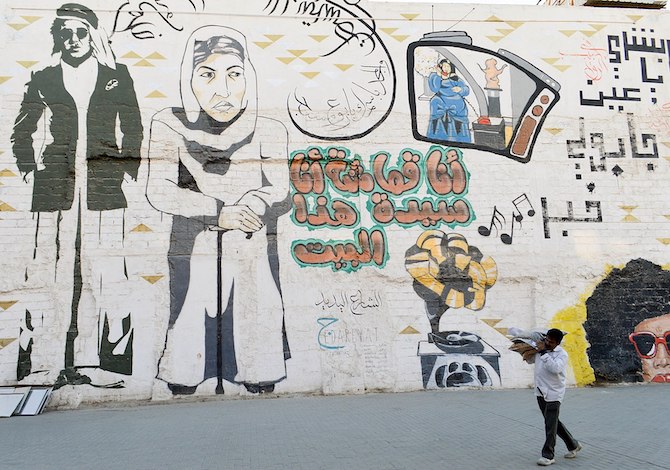by Nazanin Shahrokni and Spyros A. Sofos
April 5th, 2022

A market worker walking in front of a wall full of graffiti in Kuwait City. Source: Francisco Anzola
Originally a small fishing and pearl diving settlement, Kuwait City became a key point in the East India Company sea routes to India and the east coast of Africa in the 18th century. The affluence brought about by the discovery of oil in the 20th century set in motion a dramatic transformation of the Persian Gulf emirate and Kuwait City whose population rose from 62,627 in 1950 to a staggering 3,115,000 in 2021. Kuwait’s gas and oil extraction industry and the service economy that emerged, relied on the import of foreign workers whose number increased dramatically over the years from nearly 31 percent of the population in 1957, to 70 percent in 2022. In response to a demographic shift of such magnitude, Kuwait’s ruling family had to reimagine and rebuild Kuwait City. Central in the redevelopment was the vision of a modern administrative and commercial centre whose periphery expanded rapidly towards the desert surrounding it. In this periphery, new residential suburbs housed the inhabitants who were granted citizenship. Yet, the vision of a modern Kuwait City had little space for those indigenous and migrant populations whose presence and labour were crucial to the materialisation of a new Kuwait City.
Differential inclusion and exclusion processes have fragmented Kuwait City’s population and shape how these fragments inhabit, relate to and experience it. This coupling of fragmentation and inequality has created a dysfunctional urban space, lacking usable public spaces or adequate public transport, marred by high levels of motorisation and environmental degradation. The more attention one turns to the city’s fragments, the more extended the capacity for building a polyphonic city that is not only more inclusive but also efficient.
Kuwait City’s Social Ecology
According to the latest estimates, just under 1.3 million of the emirate’s population are Kuwaitis, 1.2 million are citizens of other Arab countries, approximately 1.5 million are Asian expatriates, 70,000 come from Africa and close to 40,000 from Europe, North and South America and Australia. Yet, this diversity is but one facet of a much more complex urban ecology marked by inequality and segregation.
Tensions between sedentary and nomadic populations is apparent in the form of a hierarchical distinction between the hadar – settled Sunni urban elite – and the badu – Bedouin tribes that used to live a nomadic life in the badiya (desert) surrounding the citadel. The procedure for acquiring citizenship after independence meant that the badu were granted a ‘lesser’ citizenship: apart from the differential political rights that separated them from the hadar, unlike the latter who were relocated to the al-manãtiq al-numüdhajiyya (fifteen model ‘inner’ residential suburbs inside the four ring roads), the badu were not offered housing until the early 1980s when they were moved to modest-sized housing in outlying areas (al-manãtiq al-khãrijiyya) effectively lacking access to the city centre, its administrative services and amenities.
Another significant divide is the one between citizens and the bidun (without [citizenship]). Originating largely in itinerant groups whose lives were divided inside and outside Kuwait’s historical borders that failed to register or meet the exclusive citizenship criteria, the bidun became effective ‘outsiders’ excluded from the benefits of citizenship, not allowed to own property, denied access to free education, relying on precarious, low status jobs, or in the best case joining the low ranks of the military, police or civil service. Social outcasts, they became spatially externalised, banished to settlements in the outskirts of Kuwait City such as Tayma, Sulaibiyya and Ahmadi. These sha’biyya (popular housing), housing most of Kuwait’s 100,000 bidun, have recently become the locus of protests over their exclusion from rights enjoyed by citizens such as free healthcare and education.
The sharpest divide, though, separates citizens and expatriates – mostly lower paid workers in the oil industry, construction, services and domestic sectors. Out of the 1.77 million legally resident expatriates, over 50 percent, roughly 845,000, are illiterate or have basic education. However, statistics point to an asymmetrical distribution between this large segment of Kuwait’s population taking the most menial and vulnerable jobs and a small, highly educated migrant workforce hailing from developed countries and occupying desirable, high-earning positions in healthcare, business and finance.
Consecutive governments, disregarding Kuwait’s dependence on the contribution of migrant labour, represent them as a demographic threat and vow to reduce their numbers. Unskilled migrant workers’ lives have been subjected to restrictions that limit even their basic freedoms. They have been expendable and replaceable, and vilified in the Kuwaiti media on account of their lack of education, ‘their limited health culture,’ and, ironically, their ‘lack of direct contact with mainstream Kuwaiti society’– which is largely the product of design on the part of the authorities.
The kafala (sponsorship) system requires migrants to have a Kuwaiti sponsor (kafeel). In a highly regulated labour market, kafala empowers employers disproportionately and shields them from responsibility in cases of withholding pay, forced labour or abuse as they have the right to petition the immigration authorities to cancel workers’ legal residency, effectively giving them power over the immigration status of those they sponsor. This vulnerability, combined with their precarious presence in Kuwait, strengthens representations of foreign workers as not only outsiders but also inferior. This inferiority is reflected in and further consolidates spatial segregation policies and practices, which are gendered in character: many male workers live in temporary housing near project sites or in higher density residential areas and in the suburbs of Ḥawallī and Al-Sālimiyyah, in cramped rented housing. They are often targeted by government operations such as the 2019 ‘Be Assured’ campaign aimed to remove unmarried or unaccompanied male migrants – so-called ‘bachelors’ – from urban residential areas that left many homeless. Female domestic workers, on the other hand, live with Kuwaiti families in residential neighbourhoods not always served by bus networks as the preference for private transport among Kuwaitis has influenced public transport planning. Their mobility is thus hampered by the cost of taxis given their low income or depends on their employers as the relative lack of leisure and retail infrastructures in residential areas necessitates longer trips.
Despite a tradition of women’s activism, women are often seen as ‘out of place’ in streets, parks, malls and public transport – and are a target of harassment as grassroots initiatives such as the Lan Asket (I will not be silent) Instagram campaign seem to confirm. Patriarchal notions of ‘honour’ curtail women’s freedom of movement and the gendered character of the public/private divide make large swathes of Kuwait City unsafe for them, resulting in gendered geographies of fear. Furthermore, female migrant workers, especially those employed in domestic settings, often experience physical abuse.
The pacifying effects of the state’s welfare provision and the sense of privilege afforded to the citizens, thus, rests on a second distinction between ‘deserving’ insiders and ‘undeserving’ outsiders – bidun and foreign resident labourers while gender, along other social markers of difference, intersects and leaves its own imprint on experiencing the city.
Urban Citizenship: A Bottom-Up Approach
A productive way of looking at the current divides and dysfunctionalities of life in Kuwait is to focus on the city and life in it, especially as the latter is the locus where inequalities have been inscribed in tangible, material ways. Alongside the multiple dividing lines running through Kuwait City, the rapid urbanisation has resulted in the breakdown of traditional forms of solidarity and organisation based on neighbourhoods (firjãn) and tribal kinship structures. This fragmentation and atomisation of city dwellers empowered the state and allowed it to shape the city according to the modernising vision of the ruling elite.
Yet, those populating the urban space rewrite the scripts of living in it in ways that subvert dominant visions and assert different, often splintered visualisations of the right to the city, and acts of ‘(re)assembling’ and reconnecting the urban, of creating their own spatial stories. They reconfigure and claim the city through spatial practices from below, engaging in place-making processes by making communal gardens in disused plots of lands, setting up alternative and inclusive diwanniyat at the seaside – shared spaces where the slow experience of working, living and playing with others unfolds (Amin and Thrift, 2007, p. 137). Ecologies of Belonging and Exclusion in Kuwait City seeks to draw inspiration from such instances/micro-contexts of rewriting the city from below and building a sense of urban citizenship, of starting to think creatively about how this way of ‘planning through community’, to paraphrase Rose (1996), can result in sustainable public spaces and inclusive urban design.
About the author

Nazanin Shahrokni
Nazanin Shahrokni is an Assistant Professor at the Department of Gender Studies at LSE where she is programme director of the MSc Gender and Gender Research. She is PI of the LSE Kuwait Programme 'Ecologies of Belonging and Exclusion: An Intersectional Analysis of Urban Citizenship in Kuwait City' project. Nazanin is author of the award-winning book, Women in Place: The Politics of Gender Segregation in Iran (University of California Press, 2020) and a member of the International Sociological Association Executive Board. Her research focuses on the study of feminist geographies, feminist theories of the state, urban governance, gender segregation and gendered mobility. She tweets at @ShahrokniN

Spyros Sofos
Spyros Sofos is based at the LSE Middle East Centre and is Research Officer at the LSE Kuwait Programme 'Ecologies of Belonging and Exclusion: An Intersectional Analysis of Urban Citizenship in Kuwait City' project. His latest book is Turkish Politics and ‘The People’: Mass Mobilisation and Populism (Edinburgh University Press, 2022) while his research focuses on populism, collective action, polarisation and conflict, and urban politics with particular emphasis on Turkey and the MENA region. He is lead editor of openDemocracy’s #rethinkingpopulism project and leads the Lebanon element of the Swedish Institute 'Co-design for Sustainable, Resilient and Inclusive Urban Spaces' project. He tweets at @spyrosasofos
No comments:
Post a Comment